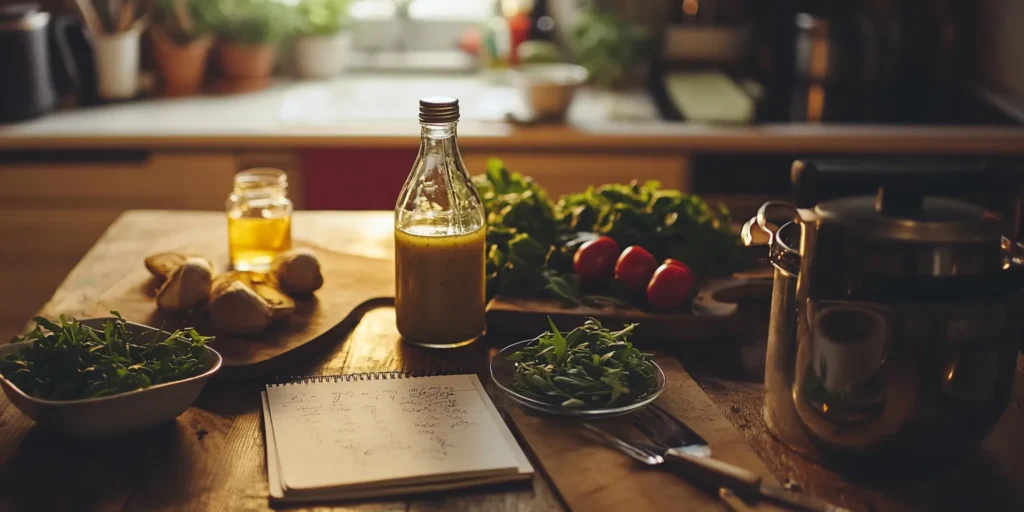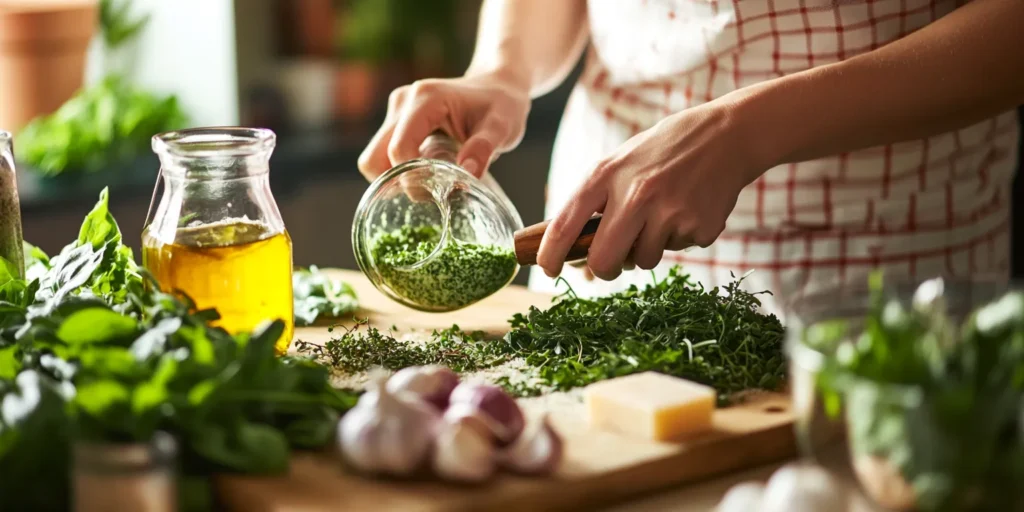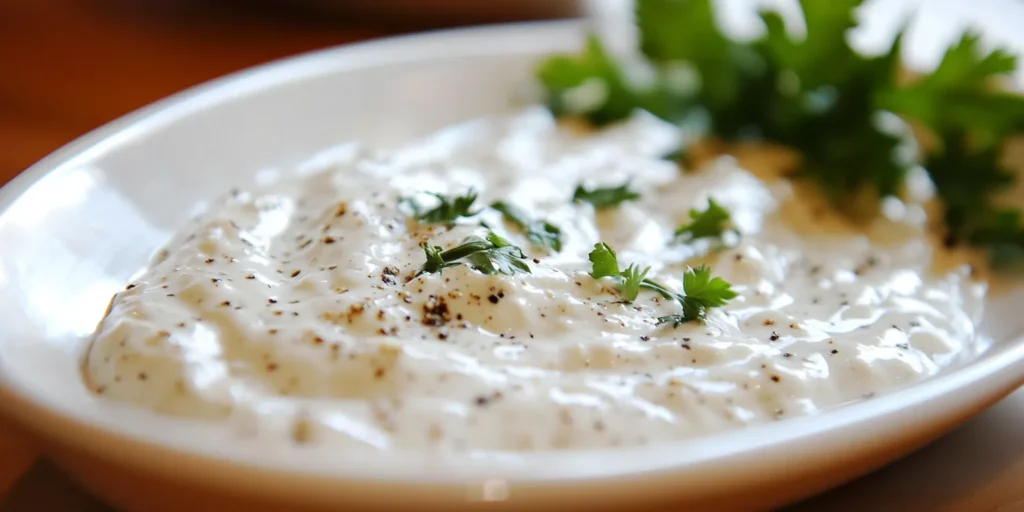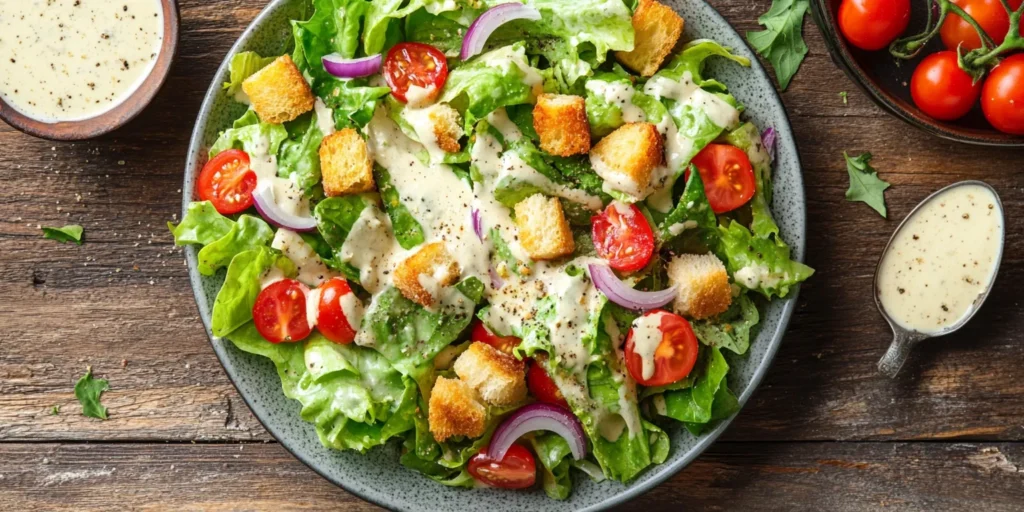Salad lovers know that a great dressing can turn an ordinary bowl of greens into something extraordinary. If you’ve ever dined at Olive Garden, then you’ve likely fallen in love with their zesty, creamy, and slightly tangy salad dressing. Fortunately, you don’t have to visit the restaurant to enjoy it!
In this article, we’ll walk you through how to make a perfect copycat version of Olive Garden’s famous salad dressing. Not only will we cover the ingredients, but we’ll also provide step-by-step instructions, variations, and even chef feedback on what makes this dressing truly special. Plus, we’ll share some fun ways to use it beyond salads!
👨🍳 Chef’s Story: Why This Recipe Works
“As a chef, I believe that great salad dressings should be simple yet packed with flavor. After all, Olive Garden’s dressing hits the right balance—it’s creamy but not heavy, tangy but not overpowering. The key, however, lies in using fresh ingredients, quality olive oil, and a perfect mix of seasonings. When you make it at home, you can adjust it to your taste, making it even better than the restaurant version!” – Chef Marco D’Angelo
Why This Olive Garden Salad Dressing Recipe Is a Must-Try
Olive Garden’s salad dressing is loved for a reason. It has a zesty Italian flavor with the perfect blend of oil, vinegar, and seasonings. But what exactly makes it stand out from other dressings? Let’s break it down.
A Perfect Balance of Flavors
The secret to this dressing’s success is the balance of acid, fat, and seasonings:
- The vinegar gives it a tangy kick.
- The olive oil and mayonnaise create a smooth, creamy texture.
- The Italian seasoning brings a burst of herby goodness.
Furthermore, this balance ensures that no single ingredient overpowers the rest, making the dressing incredibly versatile.
Pairs Well with Many Dishes
While this dressing is famous for its role in Olive Garden’s signature salad, it’s also perfect for many other dishes.
- For instance, you can use it to marinate chicken or seafood, infusing them with extra flavor.
- Additionally, it’s excellent for drizzling over roasted vegetables to make them pop.
- Finally, you can toss it with pasta salads for a refreshing touch.

Healthier than Store-Bought Dressings
Most store-bought dressings contain preservatives, artificial flavors, and excess sugar. By making it at home, however, you ensure fewer additives and more control over ingredients. This means you can also tweak it to fit dietary needs—such as making it gluten-free, dairy-free, or keto-friendly.
“When you make your own dressing, you know exactly what’s in it. That way, you avoid hidden sugars and artificial flavors—just fresh, real ingredients.” – Chef Marco
🥗 Quick Overview: What’s in Olive Garden Salad Dressing?
Before we dive into making the dressing, let’s take a quick look at its core ingredients and nutritional profile.
📝 Ingredients & Measurements
| Ingredient | Quantity | Purpose |
|---|---|---|
| Olive Oil | ½ cup | Adds richness and body |
| Mayonnaise | ¼ cup | Gives a creamy texture |
| White Vinegar | 3 tbsp | Provides tangy flavor |
| Lemon Juice | 1 tbsp | Enhances freshness |
| Sugar | ½ tbsp | Balances acidity |
| Parmesan Cheese | 2 tbsp | Adds a savory touch |
| Italian Seasoning | 1 tsp | Infuses classic herb flavors |
| Garlic Powder | ½ tsp | Adds depth of flavor |
| Salt & Pepper | To taste | Enhances overall taste |
🍽️ Nutrition Facts (Per Serving – Approx. 2 tbsp)
| Nutrient | Amount |
|---|---|
| Calories | 90 |
| Fat | 9g |
| Carbs | 1g |
| Protein | 1g |
| Sugar | 0.5g |
| Sodium | 120mg |
Ingredients Needed for the Best Olive Garden Dressing Recipe
To recreate Olive Garden’s famous salad dressing, you need the right ingredients. Each component plays a crucial role in achieving the perfect balance of creaminess, tang, and zest. Therefore, choosing high-quality ingredients is essential for the best flavor. Below, we’ll break down the essential ingredients, offer healthier substitutes, and share tips on selecting the best-quality products.
Essential Ingredients for Authentic Flavor
The classic Olive Garden salad dressing recipe includes a blend of fresh and pantry staples. However, using the right proportions is key to replicating the restaurant’s signature taste.
| Ingredient | Quantity | Purpose |
|---|---|---|
| Olive Oil | ½ cup | Adds richness and body |
| Mayonnaise | ¼ cup | Gives a creamy texture |
| White Vinegar | 3 tbsp | Provides tangy flavor |
| Lemon Juice | 1 tbsp | Enhances freshness |
| Sugar | ½ tbsp | Balances acidity |
| Parmesan Cheese | 2 tbsp | Adds a savory touch |
| Italian Seasoning | 1 tsp | Infuses classic herb flavors |
| Garlic Powder | ½ tsp | Adds depth of flavor |
| Salt & Pepper | To taste | Enhances overall taste |
“The key to getting the dressing just right is using fresh, high-quality ingredients. For instance, cheap oils or pre-grated cheese can alter the taste dramatically. Always opt for extra virgin olive oil and freshly grated Parmesan for the best results.” – Chef Marco
Healthier Substitutes for a Lighter Version
If you’re looking for a healthier alternative, you can swap a few ingredients. For example, making small changes can significantly reduce calories and fats while keeping the delicious flavor intact.
- Instead of mayonnaise, use Greek yogurt for a lighter, protein-packed dressing.
- Replace sugar with honey or maple syrup for a natural sweetness.
- Use apple cider vinegar instead of white vinegar for additional health benefits.
- Try avocado oil instead of olive oil for a more neutral flavor.
On the other hand, if you prefer a richer dressing, adding a little extra Parmesan cheese can enhance the depth of flavor.
Where to Find the Best Ingredients
The quality of ingredients matters. Thus, sourcing them from the best places ensures an authentic taste.
- Olive oil: Look for cold-pressed, extra virgin olive oil for the richest flavor.
- Parmesan cheese: Buy a block of Parmesan and grate it fresh instead of using pre-shredded. This preserves its natural oils and taste.
- Vinegar & lemon juice: Freshly squeezed lemon juice and high-quality vinegar make a noticeable difference.
Now that we’ve gathered our ingredients, let’s move on to Part 3, where we’ll go step by step to make this delicious dressing at home!
Step-By-Step Guide to Making Olive Garden’s Signature Salad Dressing
Making homemade Olive Garden salad dressing is incredibly simple. By following a few easy steps, you’ll have a fresh, flavorful dressing ready to use in minutes. Moreover, since it’s homemade, you can customize it to your preference.
Step-by-Step Instructions for the Classic Recipe
- Gather Your Ingredients: First and foremost, make sure all ingredients are measured and ready.
- Combine the Base Ingredients: Next, in a mixing bowl or blender, add olive oil, mayonnaise, and vinegar. Blend until smooth.
- Add Seasonings: Mix in sugar, Italian seasoning, garlic powder, salt, and pepper. Stir well. In addition, you can add a pinch of red pepper flakes for a slight kick.
- Incorporate the Parmesan Cheese: Then, add freshly grated Parmesan cheese and blend for a creamy texture.
- Taste and Adjust: If needed, add more vinegar for tanginess or sugar for sweetness. That way, you achieve the perfect balance of flavors.
- Chill Before Serving: Refrigerate for at least 30 minutes to allow flavors to meld together. Otherwise, the dressing may taste slightly off as the ingredients haven’t had time to blend.
“Chilling the dressing makes all the difference! It allows the flavors to blend and creates a smoother texture. If you taste it right after mixing, it won’t have the same depth.” – Chef Marco
Mixing Tips for the Perfect Consistency
- Use a blender for a smoother dressing or whisk by hand for a slightly chunkier texture.
- If the dressing is too thick, add a tablespoon of water or milk to thin it out.
- For a richer taste, let the dressing sit in the fridge overnight before using. This enhances the depth of flavor significantly.
Common Mistakes and How to Avoid Them
- Using low-quality oil: Cheap olive oil can make the dressing taste bitter. Instead, always use high-quality extra virgin olive oil.
- Skipping the resting time: Allow at least 30 minutes for the flavors to develop. Otherwise, the dressing may taste flat.
- Over-salting: Parmesan already has salt, so it’s best to add salt gradually and taste as you go.

Flavor Variations for This Copycat Olive Garden Dressing
The classic Olive Garden salad dressing recipe is already delicious, but sometimes, a little twist can make it even better! Depending on your taste preferences, you can create a creamier version, a dairy-free option, or even a spicier take on this famous dressing.
Creamy Version vs. Classic Vinaigrette Style
- Creamy Version: If you love a thicker, richer dressing, increase the mayonnaise or substitute it with sour cream or Greek yogurt. This not only makes the dressing smoother but also adds a slight tang.
- Classic Vinaigrette: If you prefer a lighter, more refreshing dressing, reduce the mayonnaise and add more olive oil and vinegar. As a result, you’ll get a zesty, restaurant-style vinaigrette.
“A small change in the ingredient ratio can completely transform the dressing. For example, if you want it richer, go for more mayo. If you want it lighter, cut back on mayo and increase the oil. It’s all about what works for you!” – Chef Marco
Low-Fat and Dairy-Free Alternatives
If you’re watching your calories or avoiding dairy, you don’t have to miss out! Luckily, you can tweak the recipe to suit your needs:
- For a low-fat version, swap mayonnaise for non-fat Greek yogurt or a light sour cream.
- For a dairy-free version, skip the Parmesan cheese and use nutritional yeast for a cheesy flavor. In addition, use vegan mayo or blended avocado for creaminess.
- For a keto-friendly dressing, replace sugar with a keto sweetener like monk fruit or stevia.
On the other hand, if you prefer a bolder taste, adding a little extra Parmesan cheese can enhance the depth of flavor.
Adding Extra Herbs and Spices for a Unique Twist
If you love bold flavors, try adding these extras:
- Red Pepper Flakes – For a slight spicy kick.
- Fresh Basil or Parsley – For a fresh, herby boost.
- Honey or Maple Syrup – For a naturally sweet touch.
- Dijon Mustard – Adds depth and a mild tanginess.
“Small additions like fresh herbs or a dash of Dijon mustard can elevate the dressing. In fact, experimenting with flavors is the best way to make it your own!” – Chef Marco
The Best Ways to Use Your Homemade Olive Garden Salad Dressing
While this Olive Garden salad dressing recipe is famous for its role in a garden-fresh salad, it can be used in many other ways! In fact, this versatile dressing enhances a variety of dishes, from grilled meats to roasted veggies. Therefore, it’s a must-have staple in your kitchen.
Perfect Salad Combinations
Of course, this dressing pairs beautifully with classic salads, but why stop there? Try it with:
- Grilled Chicken Salad – Add sliced chicken for a hearty, protein-packed meal.
- Mediterranean Salad – Toss it with cucumbers, feta, olives, and tomatoes for a fresh Mediterranean vibe.
- Pasta Salad – Mix it with cooked pasta, cherry tomatoes, and spinach for a quick, refreshing dish.
“Salads taste better when the dressing complements the ingredients. For instance, pair zesty dressings with crisp veggies and creamy dressings with hearty toppings.” – Chef Marco
Using it as a Marinade for Chicken or Seafood
Did you know this dressing works as an amazing marinade too? Because of its balance of acid and fat, it tenderizes meats and infuses them with deep flavor.
- Chicken – Marinate chicken breasts in the dressing for at least 30 minutes before grilling. This allows the flavors to fully penetrate the meat.
- Shrimp – Toss raw shrimp in the dressing and let it sit for 15 minutes before cooking. That way, the shrimp absorbs just the right amount of seasoning.
- Salmon – Brush the dressing over a salmon fillet before baking or pan-searing. As a result, it develops a rich, tangy glaze.

Drizzling Over Roasted Vegetables or Pasta Salads
This dressing isn’t just for greens! In addition, it enhances roasted veggies and pasta dishes.
- Roasted Vegetables – Drizzle over roasted zucchini, bell peppers, or asparagus for an extra burst of flavor.
- Pasta Salad – Mix with pasta, grilled chicken, and cherry tomatoes for a quick and easy meal.
- Grain Bowls – Pour over quinoa or brown rice bowls for a Mediterranean touch.
“A good dressing isn’t just for salads. On the contrary, drizzling it over roasted veggies or pasta brings out a whole new level of flavor!” – Chef Marco
For more delicious recipes, check out our recipe collection for more exciting ways to elevate your meals!
How to Store and Preserve This Homemade Olive Garden Salad Dressing
Once you’ve made this Olive Garden salad dressing recipe, you’ll want to keep it fresh for as long as possible. Proper storage is key to maintaining its creamy texture and bold flavor. Therefore, knowing the best storage methods will help you enjoy it longer.
Best Containers to Keep It Fresh
Choosing the right container is important. If stored correctly, your dressing will stay fresh longer and taste just as good as the day you made it.
- Glass jars with tight lids – These are the best option because glass doesn’t absorb flavors, thus, keeping your dressing fresh.
- Plastic squeeze bottles – A convenient choice if you plan to drizzle the dressing over salads frequently. However, be sure to use BPA-free bottles to maintain quality.
- Mason jars – Great for easy shaking and mixing before each use.
“Glass is my go-to storage method because it keeps flavors pure. On the other hand, plastic can sometimes absorb odors, which may alter the taste.” – Chef Marco
How Long Does Homemade Dressing Last?
Since this Olive Garden salad dressing recipe doesn’t contain preservatives, it won’t last as long as store-bought dressings. However, with proper storage, you can enjoy it for several weeks.
- Refrigerator: The dressing stays fresh for up to 2 weeks when stored in an airtight container. Be sure to shake it before each use to keep the ingredients well blended.
- Room Temperature: Since it contains mayo and cheese, never store it outside the fridge for long periods.
- Signs of Spoilage: If you notice a sour smell, color changes, or separation that doesn’t mix after shaking, it’s best to discard it.
Tips for Freezing and Long-Term Storage
While it’s best to enjoy fresh dressing, you can freeze it if needed. However, freezing may slightly alter the texture.
- To Freeze: Pour the dressing into an ice cube tray for easy portioning. That way, you can thaw only what you need.
- To Thaw: Let the dressing sit in the refrigerator overnight. Then, shake or blend it to restore the creamy consistency.
“Freezing works, but it’s not perfect. Therefore, if you plan to store dressing for longer periods, I suggest making a fresh batch instead.” – Chef Marco
FAQs About This Olive Garden Salad Dressing Recipe
Many people have questions about this Olive Garden salad dressing recipe before making it at home. To make things easier, we’ve answered some of the most common ones below.
1. Can I make Olive Garden Salad Dressing without mayonnaise?
Yes! If you prefer a lighter dressing, you can replace mayonnaise with:
- Greek yogurt for a tangy, high-protein alternative.
- Sour cream for a creamy texture with a little extra zing.
- Avocado for a dairy-free, creamy substitute.
“Mayo gives it that classic richness, but Greek yogurt is my favorite substitute. In addition, it keeps the dressing creamy while adding a protein boost.” – Chef Marco
2. What is the best substitute for white wine vinegar in this dressing?
If you don’t have white wine vinegar, don’t worry! Fortunately, you can use these alternatives:
- Apple cider vinegar – Adds a mild sweetness.
- Red wine vinegar – Makes the dressing a bit tangier.
- Lemon juice – Gives a fresh citrusy kick.
Each option will slightly change the flavor, so choose based on your preference!
3. Is this dressing gluten-free and keto-friendly?
Yes! The good news is that this homemade dressing is naturally gluten-free. However, for a keto-friendly version, replace the sugar with a low-carb sweetener like monk fruit or stevia.
“Since homemade dressings don’t contain hidden preservatives, they’re often healthier than store-bought versions. As a result, making this at home is a great option for anyone on a gluten-free or keto diet!” – Chef Marco
4. How can I make the dressing thicker or thinner?
Sometimes, you might want a different consistency. Luckily, adjusting it is simple.
- To thicken it, add more Parmesan cheese or mayonnaise. This creates a richer, creamier dressing.
- To thin it out, mix in a little water, milk, or olive oil. That way, you can adjust it to your desired consistency.
“I always recommend making the dressing a little thicker at first. After all, it’s easier to thin it later than to fix a runny dressing!” – Chef Marco
Now that you know everything about making, storing, and customizing this Olive Garden salad dressing recipe, it’s time to give it a try! Once you taste how fresh and flavorful it is, you may never buy store-bought dressing again. 😊
Serving Suggestions for the Best Olive Garden Copycat Dressing
Once you’ve prepared this Olive Garden salad dressing recipe, the next step is deciding how to serve it. While it’s perfect for salads, it also works as a dip, a marinade, or even a sauce for various dishes. Below, we’ll explore some of the best ways to enjoy this zesty, creamy dressing.
Best Salads to Serve with This Dressing
Of course, this dressing pairs wonderfully with Olive Garden’s signature house salad. However, it also works well in many other salads:
- Classic Garden Salad – Crisp lettuce, cherry tomatoes, red onions, and croutons tossed with this dressing create a refreshing dish.
- Grilled Chicken Caesar Salad – For an extra layer of flavor, use this dressing instead of Caesar dressing.
- Mediterranean Chickpea Salad – Combine chickpeas, cucumbers, tomatoes, and feta cheese for a protein-packed meal.
- Strawberry Spinach Salad – The dressing’s tangy flavor balances well with sweet strawberries and crunchy pecans.
“Salads should be fun and full of flavor! This dressing makes even the simplest salads exciting and delicious.” – Chef Marco
Other Delicious Ways to Use This Dressing
This Olive Garden salad dressing recipe is more than just a salad topping! Here are a few other creative ways to use it:
- As a dip – Serve it alongside fresh veggies like carrots, celery, and bell peppers.
- As a sandwich spread – Spread a thin layer on a turkey or chicken sandwich for extra zest.
- As a pasta sauce – Toss it with warm pasta, grilled chicken, and spinach for a creamy, tangy twist.
- As a marinade – Let chicken or shrimp soak in the dressing before grilling for an extra punch of flavor.
“A great dressing should be versatile. That’s why I love this one—it works for salads, meats, and even pasta!” – Chef Marco

Final Thoughts on This Olive Garden Salad Dressing Recipe
One of the best things about making your own Olive Garden salad dressing is that you can adjust it to match your taste. Whether you prefer it tangier, sweeter, or even spicier, there are many ways to modify the recipe.
How to Adjust the Flavor to Your Preference
Sometimes, you might want to tweak the dressing to better fit your personal taste. Fortunately, small adjustments can make a big difference.
- For a tangier dressing – Add an extra splash of white vinegar or lemon juice.
- For a creamier texture – Increase the amount of mayonnaise or add Greek yogurt.
- For a touch of sweetness – Stir in a bit more sugar, honey, or maple syrup.
- For a hint of spice – Sprinkle in red pepper flakes or a dash of hot sauce.
“Don’t be afraid to experiment! Even a small tweak can turn this into your perfect dressing.” – Chef Marco
Making It Healthier
If you’re trying to make a healthier version of this dressing, consider these modifications:
- Use Greek yogurt instead of mayonnaise to reduce fat and add protein.
- Replace sugar with honey or a sugar-free sweetener for a lower-carb option.
- Swap out Parmesan cheese for nutritional yeast to make it dairy-free.
“Healthy doesn’t have to mean boring! With just a few changes, you can make this dressing both delicious and nutritious.” – Chef Marco
Conclusion
Now that you know how to make this Olive Garden salad dressing recipe, it’s time to try it for yourself! With its creamy texture, tangy flavor, and endless serving possibilities, this dressing is sure to become a kitchen staple.
By making it at home, you can enjoy the same great taste while customizing it to suit your preferences. Whether you drizzle it over a salad, use it as a marinade, or dip your favorite veggies in it, this dressing adds a burst of flavor to any meal.
So, what are you waiting for? Grab your ingredients and start mixing! 😊
